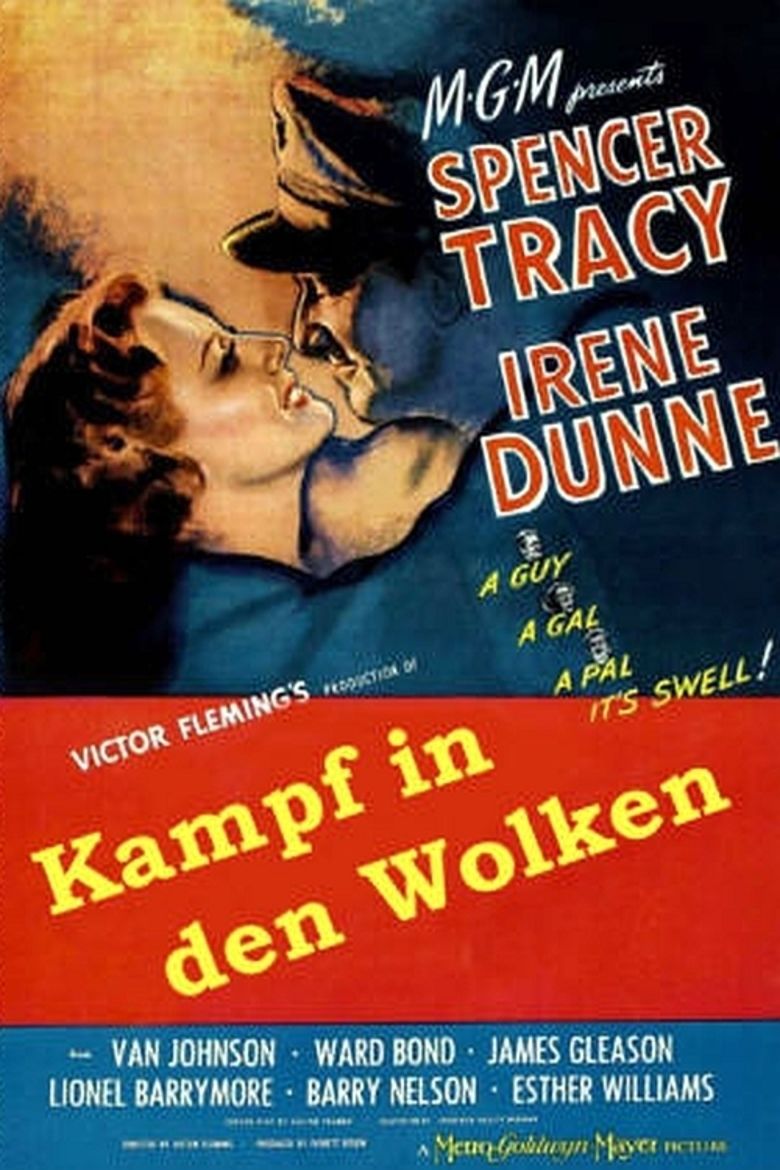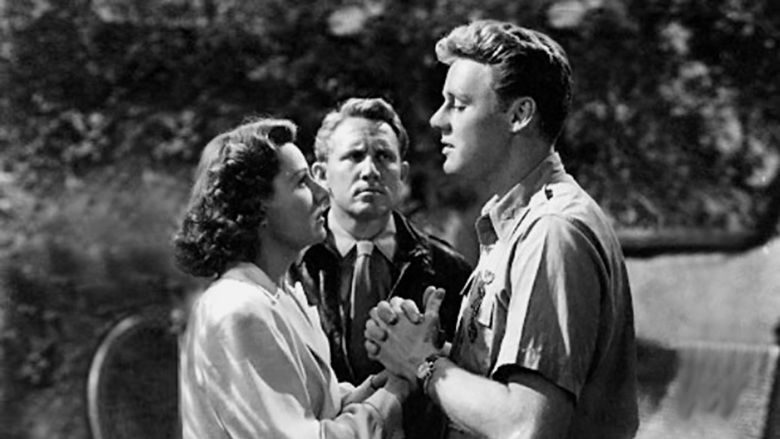A Guy Named Joe
7 /10 1 Votes7
Budget 2.627 million USD Country United States | 7/10 IMDb Genre Drama, Romance, War Duration Language English | |||||||||||||||||||||||||||||||||
 | ||||||||||||||||||||||||||||||||||
Release date December 23, 1943 (1943-12-23) Writer Chandler Sprague (story), David Boehm (story), Frederick Hazlitt Brennan (adaptation), Dalton Trumbo (screenplay) Cast (Pete Sandidge), (Dorinda Durston), (Ted Randall), (Al Yackey), ('Nails' Kilpatrick), (The General) Similar movies Interstellar , Blackhat , Self/less , Independence Day , Salt , Saving Private Ryan Tagline A Guy Named Joe is THE classic movie about a cracked up WWII bomber pilot (Spencer Tracy) sent back from Heaven as a ghost to provide guidance | ||||||||||||||||||||||||||||||||||
A guy named joe trailer 1944
A Guy Named Joe is a 1943 film released by Metro-Goldwyn-Mayer, directed by Victor Fleming, produced by Everett Riskin, from a screenplay by Dalton Trumbo, adapted by Frederick Hazlitt Brennan from a story by Chandler Sprague and David Boehm. It starred Spencer Tracy, Irene Dunne and Van Johnson, with Esther Williams in a minor role. Musically, it featured the popular song "I'll Get By (As Long as I Have You)" by Fred Ahlert and Roy Turk, sung by Ms. Dunne.
Contents
- A guy named joe trailer 1944
- A guy named joe 1943 flying lessons from tracy
- Plot
- Cast
- Production
- Aircraft used in the film
- Reception
- Box Office
- References

A Guy Named Joe was remade by Steven Spielberg in 1989 as Always with Richard Dreyfuss, Holly Hunter and John Goodman, updating it to 1989 and exchanging the World War II backdrop to one of aerial firefighting.

A guy named joe 1943 flying lessons from tracy
Plot
Pete Sandidge (Spencer Tracy) is the reckless pilot of a North American B-25 Mitchell bomber flying out of England during World War II. He is in love with Women Airforce Service Pilot Dorinda Durston (Irene Dunne), a civilian pilot ferrying aircraft across the Atlantic. "Nails" Kilpatrick (James Gleason), Pete's commanding officer, first transfers Pete and his crew to a base in Scotland and then offers him a transfer back to America to be a flying instructor. Dorinda has a feeling that Pete's "number is up" and begs him to accept. Pete agrees, but goes out on one last mission with his best friend Al Yackey (Ward Bond) to check out a German aircraft carrier. Wounded after an attack by an enemy fighter, Pete has his crew bail out before bombing the ship and crashing into the sea.
Pete then finds himself walking in clouds, where he first recognizes an old friend, Dick Rumney (Barry Nelson). Suddenly becoming uneasy after remembering that Dick went down with his aircraft in a fiery crash, Pete says, "Either I'm dead or I'm crazy." Dick answers, "You're not crazy." Dick ushers Pete to a meeting with "The General" (Lionel Barrymore), who gives him an assignment. He is to be sent back to Earth, where a year has elapsed, to pass on his experience and knowledge to dilettante Ted Randall (Van Johnson) at flight school, then in the South Pacific, where Ted is a Lockheed P-38 Lightning fighter pilot. Ted's commanding officer turns out to be Al Yackey.
The situation becomes complicated when Ted meets the still-grieving Dorinda. Al encourages Dorinda to give the young pilot a chance. The pair gradually fall in love; Ted proposes to her and she accepts, much to Pete's jealous dismay.
When Dorinda finds out from Al that Ted has been given an extremely dangerous assignment to destroy the largest Japanese ammunition dump in the Pacific, she steals his aircraft. Pete guides her in completing the mission and returning to the base to Ted's embrace. Pete accepts what must be and walks away, his job done.
Cast
As appearing in screen credits:
Production
A Guy Named Joe introduced Van Johnson in his first major role. When the filming was partially completed in 1943, Johnson was in a serious automobile accident. The crash lacerated his forehead and damaged his skull so severely doctors inserted a plate in his head. MGM wanted to replace Johnson, but Tracy convinced the studio to suspend filming until Johnson could return to work, which he did after four months of recovery. He then went on to become a major star. Because the movie was filmed before and after the accident, Johnson can be seen without and with the forehead scars he bore from then on.
One of the other reasons Johnson was allowed to stay was because a deal was made that Tracy and director Victor Fleming had to stop making Dunne's life miserable on set. Although she had been excited to work with Tracy, the actor took an instant dislike to her and endlessly teased her, sometimes driving her to tears. The deal was made, and Dunne and Tracy took the extra time caused by Johnson's recovery to re-shoot some of the scenes where their hostility was noticeable.
Budget restrictions precluded location shooting, and all the flying scenes were staged at the MGM Studios. For an air of authenticity, footage shot at various United States Army Air Forces (USAAF) bases throughout the United States was incorporated via an exterior backdrop process. Authentic aircraft were used, although they remained firmly on the ground. The pivotal scene with Irene Dunne flying a Lockheed P-38 Lightning was recreated at Drew Field, Florida, utilizing a surplus P-38E which had been acquired from the USAAF, where it had been used as an instructional aircraft. Electric motors drove the propellers and allowed for an authentic run-up sequence. The miniature work was the product of the same MGM special effects team of A. Arnold Gillespie, Donald Jahrus and Warren Newcombe that would later be responsible for Thirty Seconds Over Tokyo (1944).
During the scene where Tracy's character dies, he was shown making a suicidal divebomb run on a German aircraft carrier, despite the fact that Germany has never had an operational aircraft carrier in service, before, during or after World War 2.
Aircraft used in the film
Reception
A Guy Named Joe premiered at the Astor Theater in New York on 23 December 1943 to generally positive reviews. Life Magazine summed up the critical reaction: "MGM's A Guy Named Joe manages to remain strong and exciting despite such weaknesses as verbiosity and a climax that is pure 'Perils of Pauline'." Bosley Crowther of The New York Times considered it "a tricky excursion into metaphysical realms." that almost comes off.
The Academy of Motion Picture Arts and Sciences nominated the team of David Boehm and Chandler Sprague for Best Original Story in 1944, but Leo McCarey won for Going My Way, at the 17th Academy Awards.
The film is recognized by American Film Institute in these lists:
Box Office
According to MGM records the film earned $3,970,000 in the US and Canada and $1,393,000 elsewhere resulting in a profit of $1,066,000.
References
A Guy Named Joe WikipediaA Guy Named Joe IMDbA Guy Named Joe themoviedb.org
